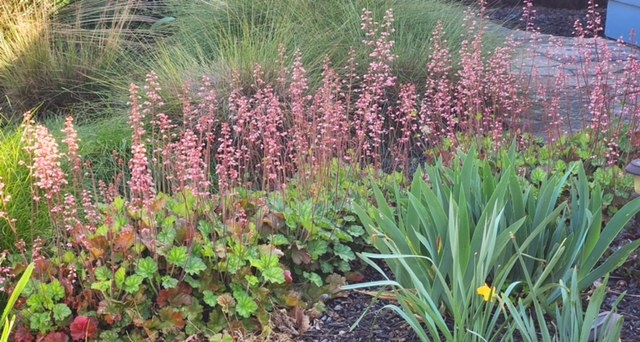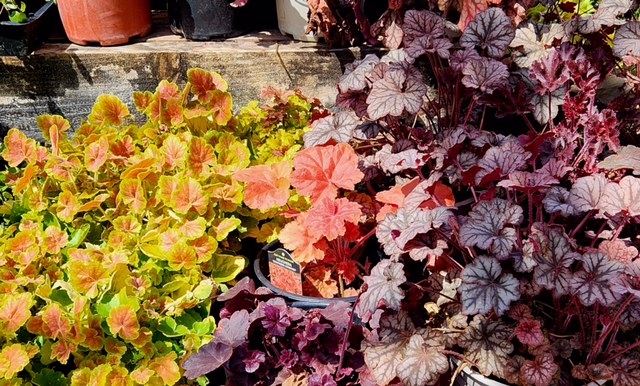Shakespeare may have believed that a rose by any name would smell as sweet, but a well-considered plant name—or an ineptly chosen label—can significantly enhance or tarnish its subject forever. In the plant world, botanical nomenclature experts frequently name plants after their “discoverers” and rarely consider how those names might affect a plant's future popularity.
Saddled with a name that fails to glide off the tongue, Heuchera (pronounced HEW-ker-ah) is a family of plants that deserves better recognition for adaptability to our climate and soils, drought tolerance and, especially, the beauty of its leaves and fairy-lamp flowers.
Savvy gardeners will forgive the clumsy name and take advantage of the astonishing palette of colors. Even a modest planting of these tough specimens can turn a dull landscape into an inspired showplace.
Native to North America, the Heuchera family has successfully adapted to a wide variety of soils and climate conditions. Heuchera sanguinea—native to the American Southwest and commonly known as coral bells or alum root—was the first species to come into prominence. It is prized for its airy, bell-shaped flowers which decorate slender stems above compact, evergreen foliage mounds.
Knowledgeable landscapers use Heuchera as ground covers, borders, and rock garden specimens. Bees, hummingbirds, and other pollinators are attracted to Heuchera blossoms, adding yet another incentive to include them in local gardens.
The sturdy Heuchera has proved adaptable to many climates, such as the wind-swept terrain of California's Channel Islands, the varied seasons of the Mid-Atlantic region and the deserts of Arizona, New Mexico, and northern Mexico. What makes these hearty plants so special for Napa
Valley is their water-wise nature and the colorful leaves they maintain through much of the year. Many varieties send out thyrses, or flower spikes, which resemble a multitude of tiny lanterns clinging to a slender stalk.
Not only do the plants' leaves deliver an amazing range of colors—from pink to pale green, teal, gray, red, brown, and orange—but the thyrses likewise come in an assortment of blossom heights and colors. Heuchera's variety of flowers and leaves can inspire the landscape designer to employ a single color or incorporate graduated colors and textures to create an eye-catching vista. One of the easiest perennials to grow, Heuchera are virtually carefree.
Tips for Growing Heuchera:
Heuchera thrive in a wide range of light conditions, from full sun to shade. Foliage color and bloom are best when plants receive at least four to six hours of direct sunlight, although lighter-colored leaves retain their truest color in shady spots.
Plant Heuchera in spring or fall. These plants tend to mound, growing 6 to 16 inches tall and 12 to 24 inches wide. Space plants at least 1 to 2 feet apart. They are most effective in small groups alongside complementary-colored plants, massed as a groundcover or used as pathway edging.
Even though Heucheraare (more or less) drought tolerant, all plants need adequate water the first year, so don't plant it and forget it. Heuchera don't need much water once established, but a good soaking may be necessary during hot spells. Irrigating regularly and applying light fertilizer in the first year should be sufficient to ensure success.
Heuchera adapt to a variety of soils, but heavy clay can be challenging for them. Incorporating loam, sand and compost into clay soil should help. Heuchera will not tolerate consistently soggy soil. There are approximately 37 major varieties of Heuchera, and the many hybrids provide a kaleidoscope of options. Consider these suggestions for Napa Valley gardens:
‘Old La Rochette' produces two-foot-tall stems with crowds of long-lasting pink blossoms in spring above clumps of green foliage.
‘Opal' blooms begin white but change to pink as they age.
‘Palace Purple' is renowned for its deep purple, maple-like foliage in sun or part shade. It is tolerant of both coastal conditions and clay and needs only moderate water.
‘Santa Ana Cardinal' and ‘Susanna' feature deep red flowers.
‘Peach Crisp' is prized for its colorful orange leaves.
The California Native Plant Society website provides useful information on Heuchera. Just type “Heuchera” into the search bar to reveal the range and suitability of various varieties in this area.
The genus was named after Johann Heinrich von Heucher, an 18th-century German academician and physician. Alas, the less-than-mellifluous “Heuchera” goes down in gardening history as a name that doesn't sell well.
But let's look on the bright side. Possibly because of its forbidding moniker, Heuchera escaped mainstream patronage and thereby avoided mall-landscape overuse. Instead of denouncing 18th-century botanical labelers, perhaps we should thank them for inadvertently preserving a gardening secret.
Library Talk: Join UC Master Gardeners and Napa County Library for “All About Lavender,” on Thursday, June 6, from 7 pm to 8 pm, via Zoom. Have you ever wondered what you can do with that gorgeous lavender growing in your backyard? Learn what lavender needs to thrive, and harvest ideas for how to incorporate it in your own homemade creations. Register to receive the Zoom link.
Workshop: Join UC Master Gardeners of Napa County for a workshop on “Planting for Monarchs and Other Pollinators” on Sunday, June 16, from 2 pm to 4 pm, at Yountville Community Center, 6516 Washington Street, Yountville. Learn about host plants and nectar plants and how to include them in your garden. This workshop is offered in partnership with Yountville Parks and Recreation Department. Register on their website. Click Adult Activities, then UC Master Gardeners, then Planting for Monarchs and Other Pollinators.
Help Desk: The Master Gardener Help Desk is available to answer your garden questions on Mondays and Fridays from 10 am until 1 pm at the University of California Cooperative Extension Office, 1710 Soscol Avenue, Suite 4, Napa. Or send your questions to mastergardeners@countyofnapa.org. Include your name, address, phone number and a brief description.

